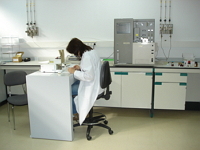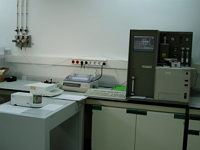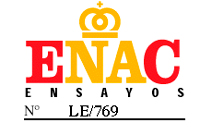ELEMENTAL MICROANALYSIS: THE STUDY OF LIFE-ASSOCIATED CHEMICAL ELEMENTS
|
Description |
Combustion elemental microanalysis allows the quantitation, in a single experiment, of the weight contents of the main elements associated with life, i.e. carbon, hydrogen, nitrogen and sulfur. This determination can be carried out on most kinds of solid, liquid and viscous samples, and is not accesible by other techniques. It has the additional advantage of being quick and inexpensive.
The main application fields of the combustion microanalysis technique are:

Analysis of samples and purities of compounds.
1. Identity and purity of synthetic compounds
Combustion microanalysis is used to establish compound purity by comparing the experimental values of carbon, hydrogen, nitrogen and sulfur with the ones predicted from the compound’s molecular formula. Furthermore, it provides data that help to confirm the structure of a newly synthesized compound, in conjuction with other techniques. It requires very small amounts of simple (around 1 mg), which is an advantage when studying scarce materials, such as compounds synthesized at the research lab scale.
2. Analysis of pharmaceutical products
Because most excipients used by the pharmaceutical industry lack nitrogen, the quantitation of this element allows the determination of active principle content in pharmaceutical dosage forms, provided they do not correspond to drug combinations.
3. Analysis of materials
CHNS analysis has many applications in the study of materials. One example is the control of the process of surfactant removal during the synthesis of mesoporous silica nanoparticles.
4. Analysis of fuels
CHNS analysis has many applications in this field, including:
- Quality control: Quantitation of contaminant impurities. The determination of sulfur and nitrogen content in fuels is of great importance because these elements generate highly polluting sulfur and nitrogen oxides.
- Direct determination of the hydrogen/carbon ratio in fuels. This parameter is connected to the amount of energy released in the fuel combustion, and also with the associated CO2 emissions.
- Elemental analytical data allow the calculation of the heat of combustion of fuels, defined as the heat released upon complete combustion 1 kg (sometimes, 1 m3) of fuel. Again, this parameter is essential in order to judge the quality of a fuel.

5. Agricultural and environmental analysis
Some parameters that are accesible through CHNS quantitation are of great importance in agriculture:
- C and N content in soils is connected to the amount of organic matter and hence to soil fertility. Thus, C content is an indication of the ability of the soil to provide plants with organic nutrients, while N content is usually the limiting factor in the growth of plants, since it is connected to their ability to synthesize proteins and nucleic acids. These parameters are usually given as the soil C/N ratio.
- Fertilizer analysis. Fertilizers are added to soils to modulate their C/N ratio through their degradation by soild microorganisms. The C/N ratio of the fertilizer itself is important to jugde its quality.
- Micronutrient levels in plants. Suitable S and N levels are necessary for protein biosynthesis to proceed.
Besides soils analysis, there are other environmentally relevant studies that can be aided by combustion microanalysis experiments:
- CHN quantitation in oceanographic filtrates gives an idea of nutrient availability and hence it allows monitoring of marine trophic chains. These data are used to study eutrophication phenomena, where the presence of excess nutrients induces the growth of plants and algae, which consume oxygen during their decay and thus kill water animals.
- Paleoclimatic studies. The C/N ratio indicates if a sediment is of terrestrial of marine origin. These data give information on the ecology, climate, oceanic currents, etc. of past times.
6. Food analysis
Two examples of the application of CHN analysis to the study of foodstuffs:
- Nitrogen quantitation by combustion techniques is an alternative to the traditional Kjeldahl’s wet digestion method that is faster, cleaner, less expensive and has a lower detection limit. It has been recognized as an oficial method by many official agencies such as AOAC, AACC, ISO, DIN, ASBC, AOCS, OIV, etc.
- Sulfur content in distiller grains. These are a by-product of the production of ethanol from corn to be used as biofuel and are employed as high protein livestock feed. Their sulfur content is variable and is an important parameter, since values above 0.4% are associated to poly-encephalomalacia, a lethal neurodegenerative cattle disease.
|
How does it work |
 The National Entity of Accreditation regularly verifies the technical competence and validity of the results issued by the CAI laboratories
The National Entity of Accreditation regularly verifies the technical competence and validity of the results issued by the CAI laboratories
Combustion CHNS microanalysis is based on a “dynamic flash combustion” process, which involves combustion of the sample in a helium-oxygen atmosphere at a very high temperature, generated by an oven at ca. 970 °C and enhanced by the exothermic combustion of a container made of an easily oxidable metal (tin, silver) where the simple is packed. The combustion gases thus generated are then trapped or separated and quantified:
- Carbon, as carbon dioxide.
- Hydrogen, as water.
- Nitrogen, as N2 following the reduction of a mixture of nitrogen oxides formed in the combustion process.
- Sulfur, as sulfur dioxide.
In order to obtain good quantitative results, the weight of the simple must be known to a very high accuracy, which requires the use of microbalances or, ideally, ultramicrobalances, which can measure micrograms or tenths of microgram, respectively.
|
Advantages |
The applications summarize above show that combustion elemental microanalysis is an essential technique in many fields of academic research and in industry.
|
Where has it been developed |
The Center for Elemental Microanalysis at Universidad Complutense was created in 1994 as a centralized analytical service for UCM researchers. It has gradually acquired prestige all over Spain and nowadays it gives support to over 80 research groups in 13 Universities, 10 Research Institutes and 7 companies in several areas. It is equipped with three automatic elemental analyzers that are able to simultaneously determine carbon, hydrogen, nitrogen and sulfur. Owing to the crucial importance of accurate weighing for this technique, the Center is also endowed with two microbalances and two ultramicrobalances.
The Center received in 2003 an accreditation for the quantitation of C, H, N and S from the Spanish National Accreditation Organism (ENAC) under the ISO-IEC-17025 standard for the competence of testing and calibration laboratories. Management requirements are very similar to those in the ISO 9001 standard, but it also includes technical requirements that are aimed at guaranteen the correctness and reliability of the calibrations and tests performed in laboratory. Very few microanalytical laboratories have this level of recognition of technical competence, and the UCM Center has the broadest accredited analytical scope in Spain.
|
Contact |
|
© Office for the Transfer of Research Results – UCM |
|
PDF Downloads |
|
Classification |
|
Responsible Researcher |
José Carlos Menéndez Ramos: josecm@ucm.es
Department: CAI de Microanálisis Elemental
Faculty: Pharmacy and Chemical Sciences


